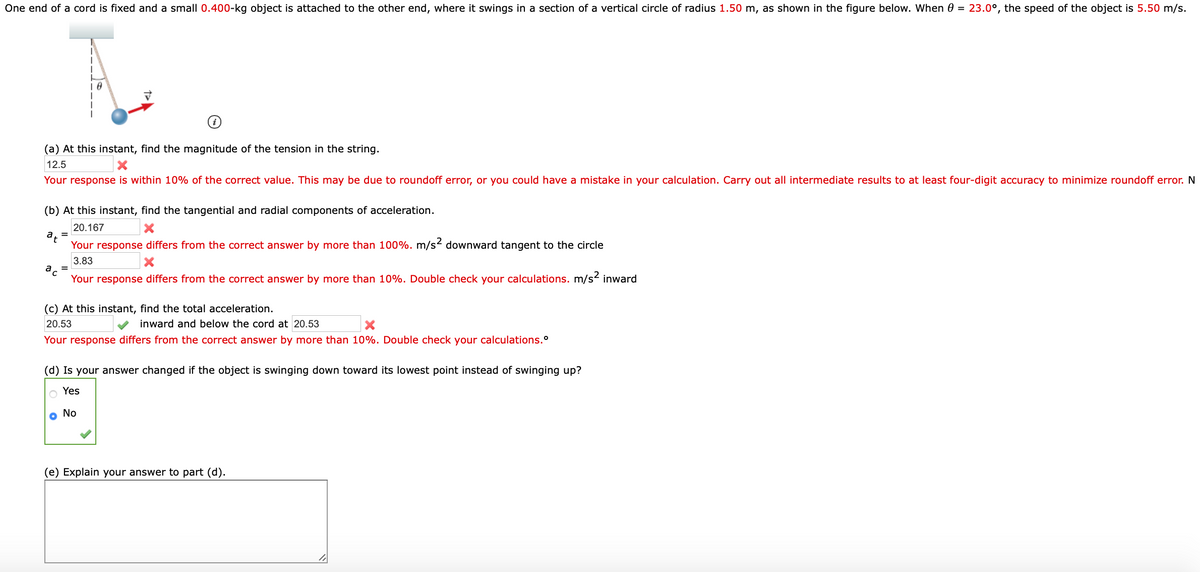One end of a cord is fixed and a small 0.400-kg object is attached to the other end, where it swings in a section of a vertical circle of radius 1.50 m, as shown in the figure below. When θ = 23.0°, the speed of the object is 5.50 m/s. An object is swinging to the right and upward from the end of a cord attached to a horizontal surface. The cord makes an angle θ with the vertical. An arrow labeled vector v points in the direction of motion. (a) At this instant, find the magnitude of the tension in the string. Your response is within 10% of the correct value. This may be due to roundoff error, or you could have a mistake in your calculation. Carry out all intermediate results to at least four-digit accuracy to minimize roundoff error. N (b) At this instant, find the tangential and radial components of acceleration. at = Your response differs from the correct answer by more than 100%. m/s2 downward tangent to the circle ac = Your response differs from the correct answer by more than 10%. Double check your calculations. m/s2 inward (c) At this instant, find the total acceleration. inward and below the cord at Your response differs from the correct answer by more than 10%. Double check your calculations.° (d) Is your answer changed if the object is swinging down toward its lowest point instead of swinging up? Yes No (e) Explain your answer to part (d).
Angular Momentum
The momentum of an object is given by multiplying its mass and velocity. Momentum is a property of any object that moves with mass. The only difference between angular momentum and linear momentum is that angular momentum deals with moving or spinning objects. A moving particle's linear momentum can be thought of as a measure of its linear motion. The force is proportional to the rate of change of linear momentum. Angular momentum is always directly proportional to mass. In rotational motion, the concept of angular momentum is often used. Since it is a conserved quantity—the total angular momentum of a closed system remains constant—it is a significant quantity in physics. To understand the concept of angular momentum first we need to understand a rigid body and its movement, a position vector that is used to specify the position of particles in space. A rigid body possesses motion it may be linear or rotational. Rotational motion plays important role in angular momentum.
Moment of a Force
The idea of moments is an important concept in physics. It arises from the fact that distance often plays an important part in the interaction of, or in determining the impact of forces on bodies. Moments are often described by their order [first, second, or higher order] based on the power to which the distance has to be raised to understand the phenomenon. Of particular note are the second-order moment of mass (Moment of Inertia) and moments of force.
One end of a cord is fixed and a small 0.400-kg object is attached to the other end, where it swings in a section of a vertical circle of radius 1.50 m, as shown in the figure below. When
the speed of the object is 5.50 m/s.
Your response is within 10% of the correct value. This may be due to roundoff error, or you could have a mistake in your calculation. Carry out all intermediate results to at least four-digit accuracy to minimize roundoff error. N
(b) At this instant, find the tangential and radial components of acceleration.
|
at =
|
Your response differs from the correct answer by more than 100%. m/s2 downward tangent to the circle |
|
ac =
|
Your response differs from the correct answer by more than 10%. Double check your calculations. m/s2 inward |
(c) At this instant, find the total acceleration.
inward and below the cord at
Your response differs from the correct answer by more than 10%. Double check your calculations.°
(d) Is your answer changed if the object is swinging down toward its lowest point instead of swinging up?
(e) Explain your answer to part (d).

Trending now
This is a popular solution!
Step by step
Solved in 4 steps


